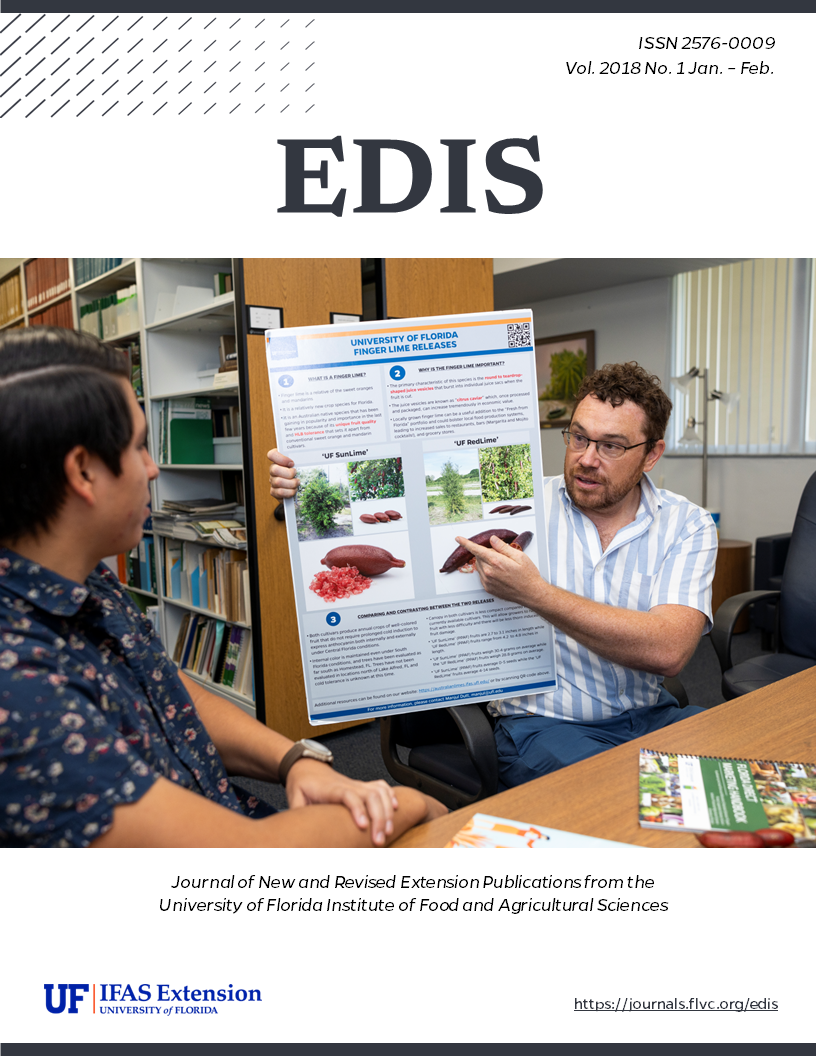Abstract
PP276 provides information on what crops white mold (Sclerotinia spp.) affects in Florida and available methods of control. Includes references. Updated August 2018.
References
Budge, S. P., and Whipps, J. M. 2001. Potential for integrated control of Sclerotinia sclerotiorum in glasshouse lettuce using Coniothyrium minitans and reduced fungicide application. Phytopathology 91:221-227. https://doi.org/10.1094/PHYTO.2001.91.2.221
Gerlagh, M., Goossen-van de Geijn, H. M., Fokkema, N. J., and Vereijken, P. F. G. 1999. Long-term biosanitation by application of Coniothyrium minitans on Sclerotiniasclerotiorum-infected crops. Phytopathology 89:141-147. https://doi.org/10.1094/PHYTO.1999.89.2.141
Hao, J. J., and Subbarao K. V. 2005. Comparative analyses of lettuce drop epidemics caused by Sclerotinia minor and S. sclerotiorum. Plant Disease 89:717-725. https://doi.org/10.1094/PD-89-0717
Hao, J. J., Subbarao, K.V., and Koike, S. T. 2003. Effects of broccoli rotation on lettuce drop caused by Sclerotinia minor and on the population density of sclerotia in soil. Plant Disease 87:159-166. https://doi.org/10.1094/PDIS.2003.87.2.159
Heffer Link, V., and Johnson, K.B. 2007. White Mold. The PlantHealth Instructor. DOI: 10.1094/PHI-I-2007-0809-01. http://www.apsnet.org/edcenter/intropp/lessons/fungi/ascomycetes/Pages/WhiteMold.aspx https://doi.org/10.1094/PHI-I-2007-0809-01
Momol, T., and Pernezny. K. 2006. Florida plant disease management guide: Tomato. PDMG-V3-53. Gainesville: University of Florida Institute of Food and Agricultural Sciences. http://edis.ifas.ufl.edu/pg059.
Pernezny, K., and Purdy, L.H. 2009. Sclerotinia diseases of vegetables and field crops in Florida. PP22. Gainesville: University of Florida Institute of Food and Agricultural Sciences. http://edis.ifas.ufl.edu/vh015.
Rollins, J. A. Sclerotinia sclerotiorum resource page. http://www.sclerotia.org/.
Subbarao, K. V., Hubbard, J. C., and Schulbach K. F. 1997. Comparison of lettuce diseases and yield under subsurface drip and furrow irrigation. Phytopathology 87:877-883. https://doi.org/10.1094/PHYTO.1997.87.8.877
Wu, B. M., and Subbarao, K. V. 2008. Effects of soil temperature, moisture, and burial depths on carpogenic germination of Sclerotinia sclerotiorum and S. minor. Phytopathology 98:1144-1152. https://doi.org/10.1094/PHYTO-98-10-1144
Wu, B. M., Subbarao, K.V. and Liu, Y.B. 2008. Comparative survival of sclerotia of Sclerotinia minor and S. sclerotiorum. Phytopathology 98:659-665. https://doi.org/10.1094/PHYTO-98-6-0659
Yanar, Y., and Miller S. A. 2003. Resistance of pepper cultivars and accessions of Capsicum spp. to Sclerotinia sclerotiorum. Plant Disease 87:303-307. https://doi.org/10.1094/PDIS.2003.87.3.303
Zhang, S.. Palmateer, A., and Pernezny, K. 2017. Florida plant disease management guide: Beans. PDMG-V3-33. Gainesville: University of Florida Institute of Food and Agricultural Sciences. http://edis.ifas.ufl.edu/pg041.
Zotarelli, L., P. J. Dittmar., M. Ozores-Hampton., N. S. Dufault., B. Wells., J. W. Noling., E. J. McAvoy., Q. Wang., C. F. Miller 2017. "Cole Crop Production", In: Vegetable Production Handbook for Florida, edited by G. E. Vallad., H.

